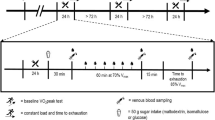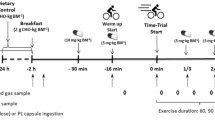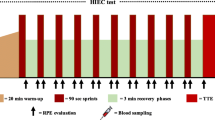Summary
The influence of a 24 h fast on endurance performance and the metabolic response to maximal cycle exercise was investigated in 6 healthy men (mean±SD: age = 21±7 years; weight = 73±10 kg;\(\dot V_{O_{2\max } }\) = 46±10 ml·kg−1·min−1). Subjects performed in randomised order two exercise bouts to exhaustion separated by one week. Test rides were performed in fasted (F) and post-absorptive (normal-diet, ND) conditions on an electrically braked cycle ergometer at a workload equivalent to 100% of\(\dot V_{O_{2\max } }\) . Acid-base status and selected metabolites were measured on arterialised venous blood at rest prior to exercise and at intervals for 15 mins following exercise. Exercise time to exhaustion was shorter after F compared with ND (p<0.01). Pre-exercise blood bicarbonate (HCO3 −) concentration,\(P_{CO_2 }\) and base excess (BE) were lower after F compared with ND (p<0.05). Prior to exercise, circulating concentrations of free fatty acids (FFA), gb-hydroxybutyrate (B-HB) and glycerol were higher after F compared with ND (p<0.01) but blood glucose and lactate concentration were not different. On the F treatment, after exercise, blood pH, HCO3 −, and BE were all significantly higher (p<0.01) than on ND; blood lactate concentration was significantly lower for the whole of the post-exercise period after F compared with ND (p<0.01). Circulating levels of FFA and B-HB after exercise on the F treatment fell but levels of these substrates were not altered by exercise after ND. Blood glucose and glycerol concentrations increased following exercise on both treatments. The present study provides evidence that a 24 h fast is detrimental to high-intensity exercise performance and possibly influences the metabolic response following maximal cycle exercise. These changes may be related to the altered pre-exercise acid-base status and/or a change in the pattern of substrate utilisation.
Similar content being viewed by others
References
Asmussen E, Klausen K, Egelund Nielsen L, Techow OSA, Tonder PJ (1974) Lactate production and anaerobic work capacity after prolonged exercise. Acta Physiol Scand 90:731–742
Bergström J, Hermansen L, Hultman E, Saltin B (1967) Diet, muscle glycogen and physical performance. Acta Physiol Scand 71:140–150
Bjorkman O, Eriksson LS (1983) Splanchnic glucose metabolism during leg exercise in 60-h-fasted human subjects. Am J Physiol 245 (Endocrinol Metab 8):E443-E448
Boobis LH, Maughan RJ (1983) A simple one-step enzymatic fluorimetric method for the determination of glycerol in 20 μl of plasma. Clin Chim Acta 132:173–179
Brooks GA, Fahey TD (1984) Exercise physiology. John Wiley and Sons, New York p 177
Christensen EH, Hansen O (1939) Arbeitsfähigkeit und Errichtung. Skand Arch Physiol 81:160–171
Dill DB, Costill DL (1974) Calculation of percentage changes in volumes of blood, plasma, and red cells in dehydration. J Appl Physiol 37:247–248
Dohm GL, Tapscott EB, Barakat HA, Kasperek GJ (1983) Influence of fasting on glycogen depletion in rats during exercise. J Appl Physiol 55:830–833
Fery F, Balasse EO (1983) Ketone body turnover during and after exercise in overnight-fasting and starved humans. Am J Physiol 245 (Endocrinol Metab 8):E318-E325
Field RA (1960) Glycogen deposition diseases. In: The metabolic basis of inherited disease. McGraw-Hill, New York, pp 156–207
Forster HV, Dempsey JA, Thomson J, Vidruk E, doPico GA (1972) Estimation of arterial\(P_{O_2 }\),\(P_{CO_2 }\), pH and lactate from arterialised venous blood. J Appl Physiol 32:134–137
Gleeson M, Maughan RJ (1986) A simple enzymatic fluorimetric method for the determination of triglycerides in 10 μl of serum. Clin Chim Acta 156:97–104
Gollnick PD, Pernow B, Essen B, Jansson E, Saltin B (1981) Availability of glycogen and plasma FFA for substrate utilization in leg muscle of man during exercise. Clin Physiol 1:27–42
Greenhaff PL, Gleeson M, Maughan RJ (1987a) The effects of dietary manipulation on blood acid-base status and the performance of high intensity exercise. Eur J Appl Physiol 56:331–337
Greenhaff PL, Gleeson M, Maughan RJ (1987b) Dietary composition and acid-base status: limiting factors in the performance of maximal exercise in man? Eur J Appl Physiol 56:444–450
Greenhaff PL, Gleeson M, Maughan RJ (1988) The effects of a glycogen loading regimen on acid-base status and blood lactate concentration before and after a fixed period of high intensity exercise. Eur J Appl Physiol 51:254–259
Hermansen L (1981) Muscle fatigue during maximal exercise of short duration. Medicine Sport 13:45–52
Hickson RC, Rennie MJ, Conlee RK, Winder WW, Holloszy JO (1977) Effects of increased plasma free fatty acids on glycogen utilization and endurance. J Appl Physiol 43:829–833
Hirche HJ, Hombach V, Langohr HD, Wacker U, Busse J (1975) Lactic acid permeation rate in working gastrocnemii of dogs during metabolic alkalosis and acidosis. Pflügers Arch 356:209–222
Hultman E (1967) Physiological role of muscle glycogen in man with special reference to exercise. Circ Res 20–21 [Suppl 1] 99–111
Hultman E, Bergstom J, McLennan Anderson N (1967) Breakdown and resynthesis of phosphorylcreatine and adenosine triphosphate in connection with muscular work in man. Scand J Clin Lab Invest 19:56–66
Hultman E, Sahlin K (1980) Acid-base balance during exercise. In: Hutton RS, Miller D (eds) Exercise and sports science reviews. Franklin Institute Press, Philadelphia 8:41–128
Lavoie J-M, Helie R, Cousineau D (1984) Effects of a rapid change in muscle glycogen availability on metabolic and hormonal responses during exercise. Eur J Appl Physiol 53:57–62
Lavoie J-M, Bonneau M-C, Roy J-Y, Brisson GR, Helie R (1987) Effects of dietary manipulations on blood glucose and hormonal responses following supramaximal exercise. Eur J Appl Physiol 56:109–114
Lopes J, Russell D McR, Whitwell J, Jeejeebhoy KN (1982) Skeletal muscle function in malnutrition. Am J Clin Nutr 36:602–610
Loy SF, Conlee RK, Winder WW, Nelson AG, Arnall DA, Fisher AG (1986) Effects of a 24 h fast on cycling endurance time at two different intensities. J Appl Physiol 61:654–659
Lund P (1985) UV-method with Glutaminase and Glutamate Dehydrogenase. In: Bergmeyer HU (ed) Methods of enzymatic analysis, vol VIII Metabolites 3: Lipids, amino acids and related compounds. VCF, Weinheim, pp 357–363
Mainwood GW, Worsley-Brown P (1975) The effects of extracellular pH and buffer concentration on the efflux of lactate from frog sartorius muscle. J Physiol 250:1–22
Maughan RJ (1982) A simple, rapid method for determination of glucose, lactate, pyruvate, alanine, 3-hydroxybutyrate and acetoacetate in a single 20 μl blood sample. Clin Chim Acta 122:231–240
Maughan RJ, Williams C (1981a) Effects of fasting on substrate utilization during exercise in man. Proc Nutr Soc 40:84A
Maughan RJ, Williams C (1981b) Differential effects of fasting on skeletal muscle glycogen content in man and on skeletal and cardiac muscle glycogen content in the rat. Proc Nutr Soc 40:85A
Minuk HL, Hanna AK, Marliss EB, Vranic M, Zinman B (1980) Metabolic response to moderate exercise in obese man during prolonged fasting. Am J Physiol 238 (Endocrinol Metab 1):E322-E329
Nilsson LH, Hultman E (1973) Liver glycogen in man — the effect of total starvation or a carbohydrate-poor diet followed by carbohydrate refeeding. Scand J Clin Lab Invest 32:325–330
Noma A, Okabe H, Kita M (1973) A new colorimetric microdetermination of free fatty acids in serum. Clin Chim Acta 43:317–320
Pequignot JM, Peyrin L, Peres G (1980) Catecholamine-fuel interrelationships during exercise in fasting men. J Appl Physiol 48:109–113
Radda GK, Yonge RP (1987) Fasting and metabolic control in human skeletal muscle during low-level exercise. J Physiol 390:129P
Richter EA, Galbo H (1986) High glycogen levels enhance glycogen breakdown in isolated contracting skeletal muscle. J Appl Physiol 61:827–831
Russell D McR, Leiter LA, Whitwell J, Marliss EB, Jeejeebhoy KN (1983) Skeletal muscle function during hypocaloric diets and fasting: a comparison with standard nutritional assessment parameters. Am J Clin Nutr 37:133–138
Russell D McR, Atwood HL, Whittaker JS, Itakura T, Walker PM, Mickle DAG, Jeejeebhoy KN (1984) The effect of fasting and hypocaloric diets on the functional and metabolic characteristics of rat gastrocnemius muscle. Clin Sci 67:185–194
Sahlin K, Harris RC, Nylind B, Hultman E (1976) Lactate content and pH in muscle samples obtained after dynamic exercise. Pflügers Arch 367:143–149
Siggaard Andersen O (1963) Blood acid-base alignment nomogram. Scand J Clin Lab Invest 15:211–217
Sutton JR, Jones NL, Toews CJ (1981) Effects of pH on muscle glycolysis during exercise. Clin Sci 61:331–338
Wahren J, Ahlborg G, Felig P, Jorfeldt L (1971) Glucose metabolism during exercise in man. In: Pernow B, Saltin B (eds) Muscle metabolism during exercise. Plenum Press, New York, pp 189–204
Author information
Authors and Affiliations
Rights and permissions
About this article
Cite this article
Gleeson, M., Greenhaff, P.L. & Maughan, R.J. Influence of a 24 h fast on high intensity cycle exercise performance in man. Europ. J. Appl. Physiol. 57, 653–659 (1988). https://doi.org/10.1007/BF01075984
Accepted:
Issue Date:
DOI: https://doi.org/10.1007/BF01075984




